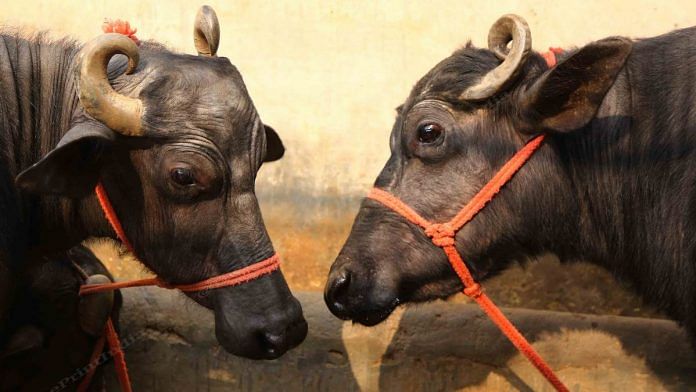New Delhi: The state of Haryana, seen as the hub of buffaloes in India, has seen a 24 per cent decline in the buffalo population since 2012, with smaller landholdings, urbanisation and sales to other states cited as the factors responsible for this.
According to the 2019 Livestock Census in the state, Haryana had 43.76 lakh buffaloes in 2019 — down from 57.64 lakh buffaloes in 2012. The fall is even higher, at 27 per cent, if compared to the 2007 census.
The livestock census is conducted every five years. However, the latest census came seven years after the previous exercise.
Haryana’s animal husbandry and dairying department released the data in May and has uploaded it on its website.
The data shows the total number of buffaloes declined the most in the districts of Bhiwani, Jind and Hisar. These are part of the Murrah belt, a reference to the most popular breed of buffaloes in the state, Murrah.
However, the cow population in the state increased by 7 per cent. From 18.07 lakh in 2012, their population rose to 19.32 lakh in 2019.
Also read: Animal welfare body pulls up Tamil Nadu govt for ‘death’ of bulls during Jallikattu
Size of landholding falling, not enough space for animals
Director General, Animal Husbandry and Dairying, Birendra Singh cited four reasons for this steady decline in the number of buffaloes.
He said the size of landholding in Haryana has been falling for the last few years, leading to people reducing the count of livestock they keep. An average farmer who previously used to rear four buffaloes is now rearing only one, said Singh.
Secondly, he added, farmers want to raise livestock of good “quality over quantity”. So, instead of keeping three normal buffaloes, farmers are now rearing a single Murrah buffalo. Singh also pointed out that though the overall numbers have fallen, milk productivity per animal has increased. In 2014-15, the productivity was at 7.79 kg per animal but this went up to 9.11 kg in 2018-19.
Citing yet another reason for the fall in buffalo count, he said other states such as Andhra Pradesh, Uttar Pradesh, Maharashtra and Karnataka have been purchasing buffaloes from Haryana. Singh said these states purchase at least 5 per cent of Haryana’s total buffaloes every year.
Ravindra Hooda, Deputy Director, Animal Husbandry, Jind, which has the second largest number of buffaloes in the state at 3.96 lakh, said states like Andhra Pradesh have been continuously procuring buffaloes of Murrah breed from Haryana for the past few years.
“The craze of rearing buffaloes has gone up in these states. On the contrary, this craze is almost ending in Haryana. This is despite the fact that promotional activities like buffalo beauty contests and ramp walk shows are being organised here from time to time,” he said.
“Urbanisation has also been a major factor behind this trend. Animal husbandry is not allowed in cities and those who are in the dairy industry also suffer losses due to increasingly expensive fodder,” added Hooda.
Asked about the increase in cow count, he said many dairy farmers are buying cows of different breeds from other states.
“Haryana imported Gir breed of cows from Gujarat in the past. Similarly, people are now buying other state’s breeds. That could be one of the reasons.”
He added, “Also, the number of cattle straying from the neighbouring states has increased. Besides, the Haryana assembly passed a cow protection bill in 2015, which later became an Act. All these factors have been working on the ground.”
‘We are only running losses’
The Haryana government has pushed many programmes to promote buffalo rearing among the youth. Local dairy farmers and others in the business are, however, not happy.
Satish Kumar, who runs a small dairy outlet in Hisar district, said milk prices have not increased for years while items related to buffalo fodder are becoming continuously expensive.
“Under these circumstances, small dairy owners like us are only running losses. We also have to employ people and pay their salaries. Many times there are frauds in procuring and selling of buffaloes, which lead to lakhs of rupees getting stuck,” said Kumar.
“In such a situation, people in even small towns and villages are staying away from animal husbandry business,” he said.
The aspiration among the youth towards private and government jobs is also responsible for this trend, said Hooda.
Also read: Elephant or cow, Hindutva doesn’t give two hoots about animal welfare. Deaths are political




Whosoever is running into loss as a dairy farmer…plz visit Hisar Veterinary College.